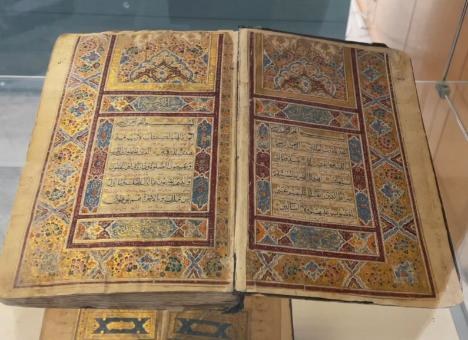MAKKAH: In an era of rapid technological change and evolving traditions, some individuals still embody steadfast devotion to craftsmanship and the quiet power of creativity.
Among them is retired teacher Khaled Al-Zahrani, who turned his retirement into a journey of fulfillment by realizing a dream he had cherished since his college days — copying the entire Holy Qur’an by hand in his own script.
Al-Zahrani, who is nearly 60, has a lifelong passion for Arabic calligraphy, especially the naskh and ruq’ah scripts. He had dreamed of hand-copying the Holy Qur’an since his university days. However, the demands of work and daily life postponed his ambition until retirement gave him the opportunity to finally turn his dream into reality.
HIGHLIGHTS
• Al-Zahrani shared with Arab News that the experience was both demanding and humbling, requiring exceptional precision and unwavering concentration, as copying the Qur’an allowed no margin for error.
• He explained that the experience strengthened his bond with the Qur’an, deepening his connection to its message while instilling a profound sense of responsibility toward the sanctity of the words he transcribed.
He explained that his journey truly began when a friend introduced him to the Qur’an by Hand initiative, which provides blank copies of the Qur’an for personal transcription. Inspired, he purchased two copies and embarked on his endeavor.
Al-Zahrani shared with Arab News that the experience was both demanding and humbling, requiring exceptional precision and unwavering concentration, as copying the Qur’an allowed no margin for error.
He carefully transcribed around two or two-and-a-half pages each day, meticulously counting the letters to ensure a balanced layout and to avoid omitting any verses.
He began with Surah Al-Zalzalah as a test of his abilities and, upon completing it, he gained the confidence to move forward, despite the profound sense of awe he felt when starting the lengthy Surah Al-Baqarah.
Al-Zahrani said that he relied on a standard half-millimeter pen and used an eraser or a fine needle to make corrections when needed, although he was meticulous to minimize errors as much as possible.
He explained that he had to devote himself fully to this work, so he decided to seclude himself in his home for six months — avoiding all distractions and social visits — so that he could finish writing the Holy Qur’an in conditions that would help him concentrate and achieve his goal.
Al-Zahrani said that his project remained out of the public eye until a relative filmed him writing and posted the video in a family WhatsApp group. The video quickly went viral, drawing widespread admiration and attention.
He added that while he received numerous requests for media interviews, he chose to delay them until he had fully completed the Qur’an, emphasizing that a task of such significance required unwavering focus and could not afford any distractions.
Al-Zahrani said that his transcription of the Qur’an was far more than an artistic pursuit or personal project: It was a profound spiritual journey that drew him into deep contemplation of God’s verses and their meanings. Every letter he penned resonated within him, as if he were living and interacting with the words themselves.
He explained that the experience strengthened his bond with the Qur’an, deepening his connection to its message while instilling a profound sense of responsibility toward the sanctity of the words he transcribed.
He also expressed the hope that his work would inspire younger generations to reconnect with the art of Arabic calligraphy, not simply as an aesthetic pursuit but as a powerful means of drawing closer to and honoring the Qur’an.
Al-Zahrani believes that his experience taught him profound lessons in patience and perseverance, calling it one of the most meaningful chapters of his life.
He expressed hope that his story would inspire others with long-delayed dreams to take the first step toward realizing them, no matter how late it may seem, proving that with sincere determination, dreams can indeed become reality.






























